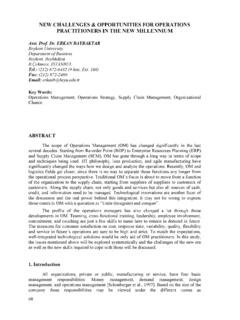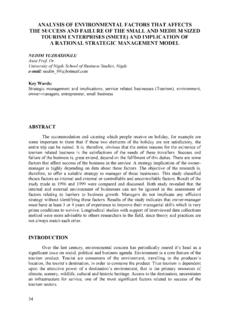Transcription of SURVIVAL STRATEGIES FOR COMPANIES IN GLOBAL …
1 394 SURVIVAL STRATEGIES FOR COMPANIESIN GLOBAL BUSINESS WORLD A CASE STUDYMURAT KASIMO LU1 Ass. Prof. Dr. anakkale 18th March UniversityDepartment of ManagementTel.: 02863615711 Mobile: 05426349085e-mail: Words:challenging business world, new paradigm of business world, corporate STRATEGIES , survivingstrategiesABSTRACTIn this article my purpose is to find out main strategy that helps some of COMPANIES toget them success in competitive world. Present day we face many demands from the GLOBAL ,unpredictable and challenging business world. For surviving we must achieve productivitywhile building new and responsive work providing all the workers opportunities for both highperformance and high quality of work life. The very nature of the dynamic, complex andsometimes unpredictable environment in which we live demand this, people change theirtastes and values change , government and laws change , unless organization also change theyrisk stagnation, decline and even death.
2 With theoretical analysis also have tackled globalbanking industry as a case in order to understand empiric s organizational environment is proving to be markedly different from that ofthe past. As pointed out in all studies, GLOBAL competition, information technology, the qualityservice revolution, and diversity and ethics are forcing management of all types oforganization to totally rethink their approach to both operation and human resources. Becauseof this paradigm shift, new organizations are emerging that are more responsive to both theirinternal and external environments (Luthans, 1995). 1 Murat Kas mo lu is an assistant professor of corporate strategy and management at the anakkale 18th MarchUniversity.
3 He received his in management and organization theory from the Istanbul University. Hisresearch interests include management and organization theories specifically population ecology of place 2000 is already here in many progressive work setting. It must comesoon to others, or pressing forces of competition and social change will trap them in a spiralof decline and disarray. For managers at Levi Strauss, General Motors and otherorganizations, this means that the challenges of continued personal and professionaldevelopment will have to be met in increasingly dynamic circumstances. The business worldat large is embarking on an exciting and unpredictable path toward the future a path alongwhich both opportunities and risk will be plentiful.
4 Among the many forces of managerialsignificance, workforce diversity and a changing environment social, political, economic,and technological have been especially important in the decade of the 1990s. Theirinfluence will continue to grow as we move toward the year 2000 and beyond and new forceswill surely emerge to join them (Schermerhorn, 1993)New century and new paradigm of business worldIn business world each decade seems to bring a new way of thinking about thebusiness environment (a paradigm) and new ways of acting (corporate STRATEGIES ) (Belohlav,1996):During the 1970s, business success increasingly became associated with market growth. Tocapitalize on the growth potential existing within many divers markets, strategy in manycompanies was linked to corporate structure especially the conglomerate form.
5 Theseconglomerates largely became, both in form and substance, portfolios of business or productsthat often had few connections to each other except as a means of financial growth. Arguablythe Boston Consulting Group developed the most popular approach to corporate strategyduring this time period. As described by Naylor (1980), central to the BCG design of strategywas the Growth Share Matrix, which was defined by the attractiveness of a business(described as the rate of market growth) and company strength (described as the market sharerelative to market share of the dominant company). The popularity of the BCG model andother similar models of strategic management resulted from their intuitively appealing andeasily visualized means of achieving competitive the BCG stance, strategy largely focused on shifting resources to maximize thecontribution of either growth or cash to support the advancement of the overall corporateentity.
6 According to the Growth Share Matrix, products and businesses could be classified inone of several ways:! Stars leaders in rapidly growing markets.! Cash cows- leaders in slowing or maturing markets.! Question marks- minor players in growth markets.! Dogs minor players in slow growth decade of 1980s Porter presented new rules of competition in two works,competitive strategy (1980) and competitive advantage (1985). Porter s approach begins withan analysis of an organization s competitive environment as described in Figure 1. Therelevant forces are the threats of new entrants, bargaining power of suppliers, bargainingpower of buyers; threats of substitute products or services and rivalry or jockeying forposition among industry firm. Porter s believes these forces govern the state of industrycompetition, which must be properly addressed if organizational decision-makers are toformulate effective good SWOT analysis, from Porter s perspective, begins by examining thecompetitive forces in an organization s environment.
7 This provides a frame of reference forfurther assessment of organizational strengths and weakness. Then STRATEGIES can be chosenthat give the organization a strategic advantage relative to its competitors. Porter identifiesthree generic STRATEGIES organizations may pursue to gain this strategic advantage.! Overall cost leadership. Corporate decision making concentrated on developingfunctional policies that could exploit plant scale, the experience curve, overhead and laborcosts, and other cost related factors.! Differentiation. The products and services of a company were viewed across the industryas distinctive. Differentiation could come from a variety of sources: brand image productdevelopment, customer loyalty, distribution networks and so forth.
8 ! Focus. The two preceding STRATEGIES developed low-cost or differentiation advantagesacross an industry. In contrast, the focus strategy revolved around serving around servingspecific segments more effectively than competitors. It tried to take advantage ofcompetition that was overperforming or underperforming within market to Porter, successfully executing each generic strategy involves differentresources, strengths, organizational arrangement and managerial Rarely is a firmsuited for all decade of the 1990 has seen the focus in some COMPANIES move toward what hasbeen popularity referred to as quality (Belohlav, 1996):Quality has been put into practice in a variety of specific ways. One of the more successfulapproaches to quality has been through Total Quality Management (TQM).
9 Several elementshave been identified as integral to TQM: a focus on customers, continuous improvement inoperations and processes, total employee participation. TQM signifies a systematic processwithin a firm but the international quality study (IQS) has presented findings that showquality is more than just knowing what to do. Businesses functioning at differing levels ofperformance may not benefit alike even though the same quality efforts are being competitionRivalry among firmsThreat of New entrantsThreat of substituteProducts or servicesBargaining power ofbuyersBargaining power ofsuppliersFigure 1397 Within the current business setting however the new, evolving rules of business competitionnow emphasize (Belohlav, 1996):! Value. Tough COMPANIES are often viewed in terms of the products of and services theysell, those products and services are really only purchased for the value they firms know both how and why their products and services are being used.
10 ! Continuous renewal. Improvement of products and services, business operations, andeven organizational processes has become the basis for continually creating greater valuefor the customer while also increasing company productivity.! Core competence. In successful COMPANIES , core competence can cut across functionsand division, allowing a business enterprise to compete-perhaps in vastly differentcompetitive arenas based on its distinct skills.! Time. Using customer value as a focal point for action COMPANIES now increasingly stressswift response to customer demands. Through continuous innovation and decreasing cycletimes, they are rapidly bringing new products and services to the marketplace. However, COMPANIES will also use time creatively because under some conditions simplycompressing time is not necessarily an advantage and in fact may increase or createrisks.



